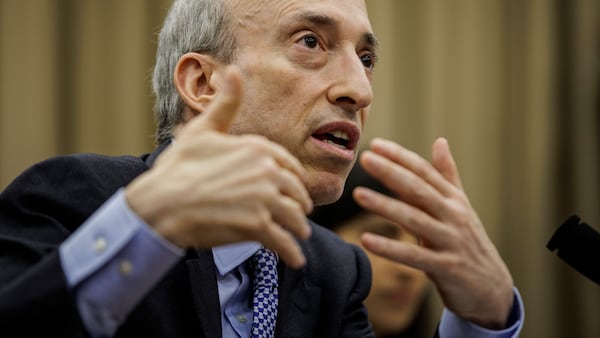- Advances in technology will make Bitcoin mining greener than ever, Marathon Digital’s chief growth officer told DL News.
- The mining company launched a pilot project in November that takes advantage of methane emissions to mine Bitcoin.
- The upcoming Bitcoin halving will put new pressure on miners to be even more energy efficient.
The Bitcoin mining industry has undergone three distinct eras, said Marathon Digital’s chief growth officer, Adam Swick.
The first miners were hobbyists. Original Bitcoiners ran the hardware in their garages.
The second phase consisted of big, commercial, public miners. Well-financed companies would simply buy hundreds of megawatts worth of power to build big mining sites.
Those days of Bitcoin miners being pure customers of utilities are gone, said Swick, leading to the industry’s third phase.
“You can no longer just show up and say, I’d like to buy a ton of power, please. Because the price you’ll get isn’t going to be competitive,” Swick told DL News.
Instead, miners now track down situations across the globe in which there exists a mismatch between energy generation and demand — for example, if a hydro plant produces too much electricity for its existing customers.
“You can no longer just show up and say, I’d like to buy a ton of power, please. Because the price you’ll get isn’t going to be competitive.”
— Adam Swick, chief growth officer, Marathon Digital
“You have to find unique scenarios where an energy company has a problem that you can solve, and that creates a win-win,” said Swick. “There is more of a symbiotic relationship between an energy producer and Bitcoin miners, rather than a customer-seller relationship.”
A new kind of game
Bitcoin mining tools have also dramatically changed — they have become more complex.
In the past, miners had to rely on air-cooled rigs, which use fans and heatsinks to dissipate the extreme heat generated by the machines. These types of rigs produce a lot of noise and tend to get clogged with dust.
Hydro-cooling and immersion-cooling have changed the game. These newer kinds of rigs either rely on closed-loop systems to circulate liquid coolant or directly submerge the machine in the coolant.
The result? Noise reduction, minimal maintenance, and most important of all, a greater potential for overclocking — a method that squeezes more hashing power to potentially get more Bitcoin out of a rig.
“At the last halving your machine was either on or it was off, it was one or zero,” explains Swick. “But now with the firmware out there and the advent of overclocking and underclocking, instead of zero or one, you can have zero, zero point five, one, or one point five in terms of how hard your machine is running.”
”That machine that you bought that had X Joules per Terahash of efficiency, you can make more or less efficient depending on how much you dial in,” he said.
Joules per Terahash refers to the amount of energy needed to produce a trillion hashes. The more hashes an operation can perform, the more chances it has to create a block and get rewarded with Bitcoins.
Essentially, miners now have more options. But it also makes mining a trickier game than it used to be. It’s “night and day” compared to what it was in 2020 for Bitcoin’s third halving, according to Swick.
The next halving
Bitcoin will undergo its fourth halving this coming April. Halving is the mechanism by which the protocol slashes by half the number of Bitcoins it gives to miners who successfully add a block to the network’s distributed ledger.
Scheduled roughly every four years, halvings have historically led to enormous bursts in Bitcoin’s price. The usual explanation: Fewer coins are mined, so fewer coins enter the market, creating a supply shock.
But with almost 93% of the total supply of Bitcoin already issued, it’s worth questioning whether the upcoming, modest reduction from 6.25 Bitcoins to 3.125 Bitcoins given to miners per block mined will have the same impact.
“Some of the Bitcoin miners are betting the firm that Bitcoin’s price increases as the halving comes,” said Swick. “A lot of them are now starting to come to the realisation that Bitcoin’s price might not double at the halving, and they might be in for some trouble.”
”Those expensive electricity contracts or hosting contracts that they signed up for in the bull market — which, mind you, was a short two years ago — may not have been the best decision,” Swick noted.
Without an accompanying increase in Bitcoin’s price, the halving will simply slash mining revenues in half, while operational costs will remain the same.
Marathon has tried to prepare for the unknown by remaining as agile as possible, according to Swick.
“That leads itself to making sure we’re pursuing the cheapest electricity, to making sure we’re finding ways to reuse the heat from the miners, because that’s potentially another revenue stream,” said Swick. “It’s investing heavily in technology, into things like developing our own firmware, our own cooling systems, things like that.”
“Because if a bear market persists, and things get really rough after that halving, all of those things help us,” he added. “If Bitcoin price skyrockets, which I hope it does to be clear, those things only help us more.”
Marathon expects to have a fleet efficiency of approximately 24 Joules per Terahash, which JPMorgan found “meaningfully better” in an October report than the aggregate Bitcoin network hashrate of roughly 30 J/TH.
The company held 13,726 BTC, worth roughly $500 million, in September and $114 million in cash in June.
Shares of the US-based public company have risen more than 190% in 2023 as the price of Bitcoin has soared this year.
Seeking opportunities
Looking for symbiotic relationships with energy producers has led Marathon to Abu Dhabi and Paraguay — and the company is open to more ideas.
It was Abu Dhabi that reached out to Marathon and not the other way around, according to Swick. The city’s air conditioners consume enormous amounts of electricity during the summer but not in the winter, which creates a “huge gap” in energy supply and demand on a seasonal basis.
Bitcoin miners are particularly well-suited to compensate for energy generation and consumption mismatches because they can be built in virtually any location and can be turned off anytime.
”Kudos to Abu Dhabi and their electrical grid,” said Swick. “They looked around on their own and said: Hey, we think Bitcoin mining can be a solution here.”
Marathon is now building a 250 megawatt line of rigs in a joint venture with Zero Two, a digital assets company backed by ADQ, Abu Dhabi’s third-largest sovereign wealth fund.
JPMorgan said that Marathon was expected to attain 30 exahashes (an exahash equals one million terahashes) per second over the next few quarters. The Abu Dhabi centre will make up roughly 23% of that mining power.
Marathon currently accounts for about 5% of the total Bitcoin network hashrate, according to the report.
Paraguay is a similar story, said Swick. The national energy provider, ANDE, could see a big portion of its hydropower going unused and recognized the value Bitcoin miners could bring.
“When you walk into the room with ANDE, they’re like: Yeah, we know what you do,” said Swick. “They had taken the time to learn and recognize the benefits. We were received with open arms.”
“It’s not like we have drawn strict geographic bounds as much as [asking ourselves], where’s the most exciting opportunity?” Swick added. “We’re willing to go wherever that is.”
As of the second quarter of 2023, Marathon was 100% carbon neutral, with 58% of energy drawn from sustainable sources, according to a company spokesman.
Actively reducing air pollution
Mining opportunities also exist in the US. On November 2, Marathon announced it had started a first site powered entirely by methane flare gas emitted from landfills in Utah.
The pilot totals 90 miners and generates 280 kilowatts of energy. For comparison, Marathon’s entire fleet consists of roughly 200,000 miners, according to Swick. He said he expected most landfills to generate four megawatts at most.
Nonetheless, he sees two great benefits in the experiment: It’s environmentally friendly and very economical. In this case, mining actively reduces air pollution while simultaneously harvesting otherwise wasted energy.
“This is the cheapest power of any of the sites we have,” said Swick, since no one else is competing for it. The site will also be producing carbon credits.
“Arguably the hardest part of it is getting the landfill excited by it. Because the landfill is like: Who the heck are you guys? What is this?” said Swick.
“This isn’t really new technology,” he added. “This is just putting together existing technologies. We didn’t have to wait 10 years to develop something. We know how to turn methane into energy. We know how to turn energy into Bitcoin money. Put them together. We can do this today.”
The hope, he added, is for other landfills to learn about the project and ask whether they could do the same thing.
“As with most Bitcoin things, there’s a belief that trying and learning by doing is good,” he said. “We’re optimistic to continue to find stories like this, both on the environmental side and on the economic side. The pilot is exceeding everybody’s expectations, operationally and economically.”
A greener future
While the Utah pilot is modest, Swick says more green opportunities will become available as time goes on.
With the advent of hydro-cooling and immersion-cooling, mining rigs now need much less maintenance. With air-cooling rigs, miners needed someone on site at all times to “fix things that are constantly breaking, bugs getting sucked into fans, dust clogging up fans,” said Swick.
Now companies only need to send someone over once a month, which potentially allows miners to set up a greater number of smaller sites.
“Do I think 100% of Bitcoin mining will be done with landfill gas? No. But could it be a meaningful percentage? Yes,” said Swick. “The growth potential is huge.”
Tom Carreras is a Markets Correspondent at DL News. Got a tip about Bitcoin mining? Reach him at tcarreras@dlnews.com









